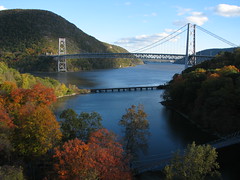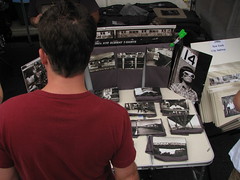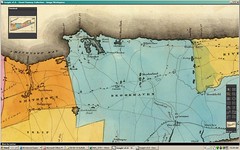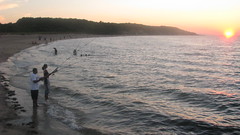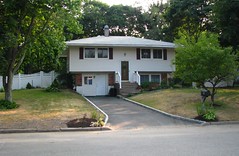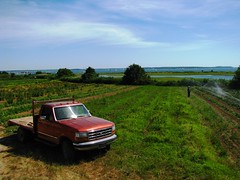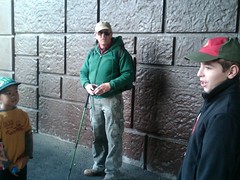
Under Amtrak NE Corridor
uploaded by Edu-Tourist
The State of New Jersey owns 102 acres of parkland/preserves in the Menlo Park section of Edison. The parcels are located in the Southern Branch of the Rahway River watershed. When combined with the County owned Roosevelt Park, and an Edison Township parcel, there are 344 acres in this watershed that are preserved.
Our tour, led by Walter Stochel and Kyle, a local scout, began at the Edison Memorial Tower - photo - at the corner of Christie Street and Tower Road. This 131' tall monument was built at the exact location of Thomas Edison's Menlo Park Laboratory. Unmarked for many years, the Tower is now on the National Register of Historic Places and features a number of descriptive markers - 1 + 2. The tower will be undergoing restoration next year and the museum reopened after the removal of asbestos insulation. The undeveloped land you see around here is the 36-acre Edison State Park.
The tour began with some discussion of the significance of the Edison Tower - image. We then walked down Tower Road, which was originally called Woodbridge Avenue, to Frederick Street. Some of the houses we passed on the left were State owned (and rented). Following the path down to the ball field, recently cleaned up as part of a Boy Scout Eagle project, and through the woods to the west, we spied Carmen's Pond - photo & description. The Carmen family owned land in Menlo Park, and Wiliam Carmen was Edison's secretary. The pond is loaded with wildlife, ducks, geese, turtles, and fish.
Forming into a tight group, we scrambled through brush along the edge of Rt. 27 (the historic Lincoln Highway) to a new crosswalk, installed in response to local advocacy. Kyle pushed the button and the light changed so that we could cross the busy highway unmolested. Proceeding down the sidewalk, we soon arrived at a recently-improved and repainted underpass. Here the group stopped and listened to the story of how 50 Cub Scouts frustrated a succession of graffiti artists to reclaim this space. As you can see from the inset photo, the rusticated surface was very attractive with the shiny new coat of reddish brown paint.
Heading further south, we again stopped to view the forest on the west side of North Evergreen Road. These woods sit on a rugged 17-acre parcel that at one time was offered to developers but instead was bought by the State of New Jersey and Edison Township to be included in the Soldiers and Sailors Preserve. It is now managed by the New Jersey Natural Lands Trust. This is a mostly wooded upland tract, now a protected wetland.
Crossing over the South Branch of the Rahway River, we entered a large wooded parcel to the left. the 49-acre main parcel of the Soldiers and Sailors Preserve. Small streams and ditches cross this property. Isolated without parking access, it has been used over the years for children't play and shelter for homeless people. In the 1980s, the State of New Jersey entered a contract to sell this parcel to a developer who wanted to build a 26-story hotel/office/parking complex on the site. In the 200s, the sale was canceled and the property was transfered to the NJ Natural Lands Trust for preservation.
There are no marked trails in this preserve. We walked east through the site, and then south towards the railroad, until, after spotting the skeleton head of a deer, we finally ended up at a wide ditch. This was the end of our trail, and we retraced our steps. Taking a different route to the road, we ran across an old rusted children's toy that may have dated back to the 1950s and several trees that showed evidence of damage from rutting deer - image.
All in all, it was an excellent two-hour adventure into a rugged and natural bit of New Jersey. It is hard to believe that such beauty survives in the middle of the most extensively urbanized state in the country. These tours are held year-round:
#6 Saturday, November 6, 2010, from 9:00 am - 12 noon
Annual Menlo
Park School Nature Trail Cleanup
Meet: Menlo Park School parking lot, on
Monroe Avenue and Edison
#7 Sunday, November 14, 2010, from 10:00 am - 12 noon
Stevens Preserve
from Petti Lane
150 acres of wood to walk in
Meet: End of Petti Lane, Edison
#8 Date and time to be announced
Annual Greenway Hike
#9 Sunday, November 28, 2010, from 10 am - 12 noon
Millbrook parcel on Mill Road
Hike beside the Mill Brook on a slate
ridge.
Meet: End of Mill Road off of Old Post Road, at the New Jersey
Turnpike
#10 Sunday, December 5, 2010, 10am
Oak Ridge Park, located in both Edison and Clark Township
Any easy hike on paved roads - includes Ash Swamp
Meet: Parking lot off Featherbed Lane, in Edison
More information on these hikes can be found on the Township of Edison website - flier.
